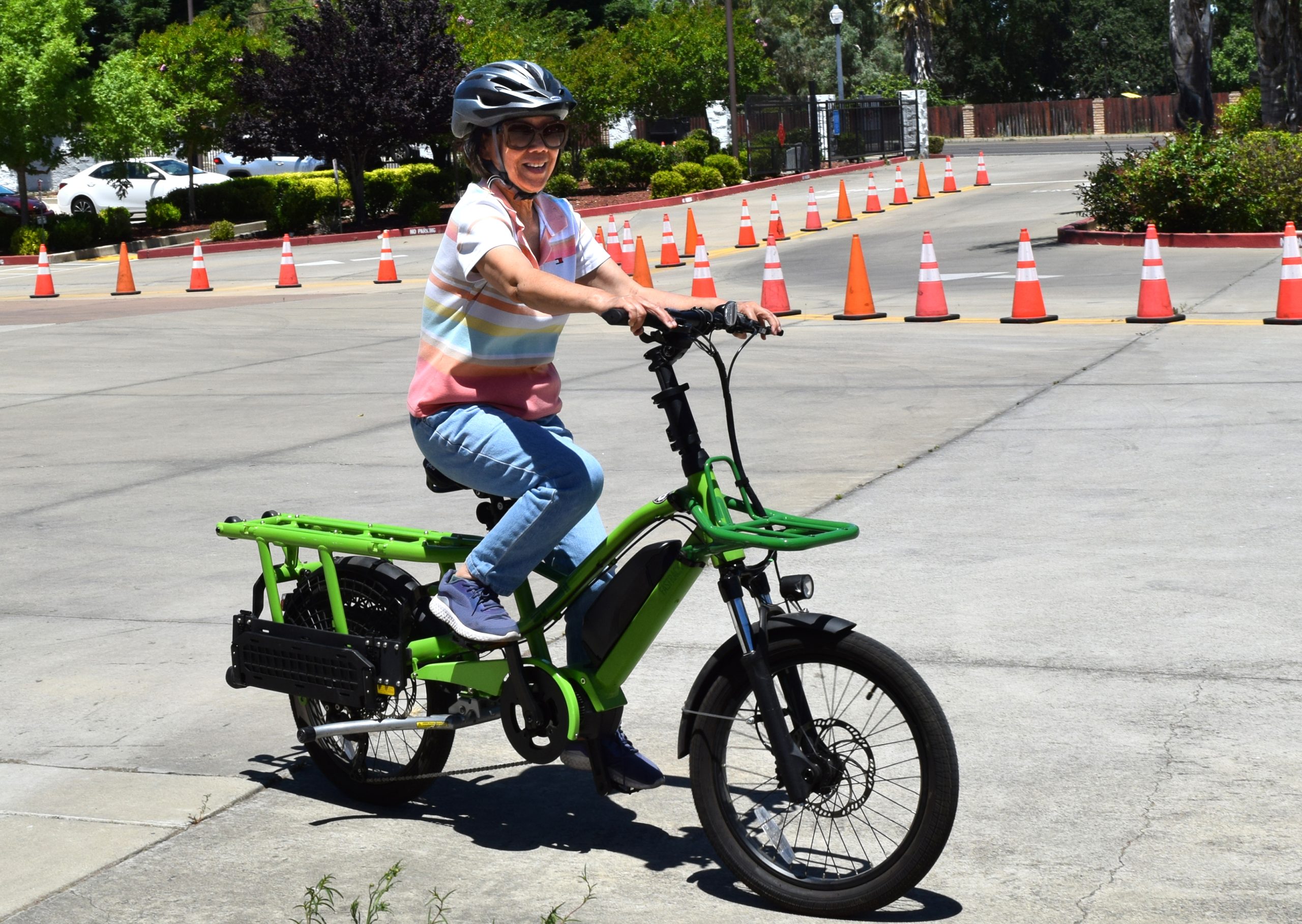E-Bikes!
Get there faster, cleaner, cheaper…and in style!

A SABA staff member explains the advantages of e-bikes at the LGBTQI+ Health Fair in Sacramento. (Credit Hillary Livingston)

Trying out an e-bike at a SABA e-bike event at the Asian Resource Center. (Credit Fayzah Mughal)
About E-Bikes
An e-bike is a regular bike with a battery powering a motor to assist with pedaling. E-bikes are fun! They help you get from point A to point B quickly and cost-effectively, and in an environmentally friendly way.
E-bikes are great for going uphill, tackling long commutes, and hauling kids or cargo. They are cheap to ride, safer in traffic, and easy to park. They are easier to ride if you have some physical limitations, and allow riders of all abilities to choose their level of effort.
E-bikes are great for going uphill, tackling long commutes, and hauling kids or cargo. They are cheap to ride, safer in traffic, and easy to park. They are easier to ride if you have some physical limitations, and allow riders of all abilities to choose their level of effort.
Find out more about e-bikes – the different types, what to consider, pricing, and where to buy:
E-Bikes 101 - English PDFE-Bikes 101 - English TextPDF de bicis eléctricas en EspañolSABA's E-Bike Activities
CA E-Bike Voucher Program
SABA is working to prepare residents to apply for the California E-Bike Voucher Program (more information below). 1,500 vouchers were issued in December 2024.
Sign up for our e-bike newsletter to stay up to date on when the program launches!
Sign up for our e-bike newsletter to stay up to date on when the program launches!
E-Bike Experience
At various events SABA gives cyclists an opportunity to experience the latest in electric vehicle (EV) technology, talk to EV owners about their experiences, learn about EV charging, and find out about incentives and rebates. SABA also does this in partnership with SMUD's Ride and Drive program.
E-Bike Education
SABA helps the local community learn about e-bikes and how to ride them. This includes people with little cycling experience or who have difficulty managing a standard bicycle.
Watch some short videos about e-bikes.
Watch some short videos about e-bikes.
E-Bike Lending
In 2025, SABA will continue the effort to get more people on e-bikes through e-bike lending projects in Sacramento.
Community Bike Shop
SABA will be collaborating with the Community Shop Class on a project that teaches young people to retrofit e-bikes, as well as repair regular bicycles.
E-Bike Legislation
We advocate for beneficial e-bike legislation with the California Bicycle Coalition (CalBike) that promotes policies in the Capital for safe and comfortable biking.

(Photo by Hillary Livingston)
California E-Bike Voucher Program
The California E-Bike Incentive Project will provide qualified applicants, based on their income, with a voucher for $1,750 towards a Class 1, 2, or 3 e-bike, or a cargo or adaptive bike. Vouchers will be applied at the time of bike purchase.
People with lower income or who live in a disadvantaged community will receive an additional credit of $250.
People with lower income or who live in a disadvantaged community will receive an additional credit of $250.
For more information about the voucher program including qualifying income, the application process, bike accessories, and which bikes qualify, please see:
Voucher Program - English PDFVoucher Program - English TextPrograma de cupones - PDF en españolE-Bike Newsletters
Resources
E-Bike Videos
E-Bike Articles
- The world’s 280 million electric bikes and mopeds are cutting demand for oil far more than electric cars, The Conversation, November 16, 2023
- Can Electric Bikes Help Save The Planet? SacTown Magazine, May 5, 2023 - From commuters to joyriders to grandmothers, e-bikes are turning non-cyclists into e-vangelists and creating a greener, less fossil-fuel-filled world.
E-Bike Research
- Portland State University's Transportation Research & Education Center: Under the leadership of TREC's sustainable transportation program manager, John MacArthur, TREC has developed a wealth of research around electric bicycles (e-bikes) to understand the potential for e-bikes to meet people's mobility needs, increase access to active transportation options, and address sustainability goals. Findings from this research have been used in policy discussions at the local, regional, state and federal level.
CalBike E-bike Resources: Information about electric bikes, e-bike regulation, and e-bike safety.






